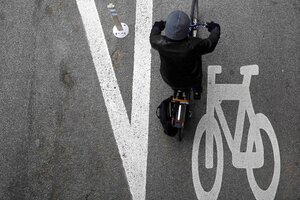Why bike sharing will make cities friendlier
New York and Chicago launch bike-sharing programs next spring, a big jump for creating a cycling culture in American cities. Life for urban dwellers will be better. Here's why.

A cyclist rides along the a protected bike lane in Chicago. Mayor Rahm Emanuel plans to add 100 miles of protected bike paths – separated from car traffic by posts or other dividers. He also plans the city's first large-scale bike sharing program.
Reuters
Next spring, New York City and Chicago plan to put a total of 15,000 bicycles on their streets, available for anyone to rent for short trips. Los Angeles may be next, following down the path of a few dozen smaller cities such as Boston and Washington, D.C., that have recently set up bike-sharing stations.
This rapid trend toward government-backed urban cycling – as well as the building of more bike-friendly streets – marks the newest form of public transit in the United States since the first subways were built more than a century ago.
Why this rush to city cycling in America, a phenomenon that has long been popular in parts of Europe and China?
One reason is that America’s mayors are competing to attract families and young people and to build tighter urban communities. Cities that are more bikable (and also walkable) allow for more personal interactions and better social cohesion than the car culture embraced in the 20th century. Bikes bring a slower, more intimate pace of life that can infuse more vitality into a city.
Young people, too, prefer to drive less these days, especially with gas prices around $4 a gallon. Those under 34 years old took 24 percent more bike trips in 2009 than just eight years earlier. And the percentage of commuters who bike to work doubled in that same period, according to federal statistics.
Chicago plans to quadruple its bike traffic over the next few years with its sharing program. It also plans 100 miles of protected lanes. New York City Mayor Michael Bloomberg has already built some 260 miles of bike lanes. The city’s bike-sharing system, backed financially by Citigroup and MasterCard, will be the largest outside Europe and China.
Building an urban biking culture isn’t easy. It requires a tipping point in which enough bikers create a certain respect and coexistence with the drivers of cars and trucks. Right now, too many cyclists disobey traffic rules and too many drivers find cyclists an annoying impediment. Bicycling evangelists often create friction in their demands for more access. And car owners are reluctant to give up space to bike lanes, which are a necessity for bike safety.
When a city gains enough cyclists, bike safety actually improves – a sort of safety in numbers. This encourages more women and children to join in. Much of the increase in biking so far has been driven by men.
As anyone who has visited Copenhagen, Denmark, or other bike-friendly cities knows, a critical mass of cycling in an urban environment brings a greater feeling of community and togetherness.
America’s car culture is hardly going away. But cities that put bikes, cars – and pedestrians – on an equal footing (or wheel) are also creating more livable places to live.

